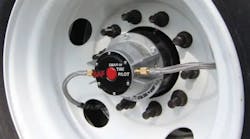The annual meeting of American Trucking Associations’ Technology & Maintenance Council provides a good overview of the latest trends in trucks, tractors, and trailers. Exhibitors there include the major OEMs and their associated suppliers in every field imaginable. If it’s related to fleet maintenance for commercial vehicles, it’s probably at TMC’s meeting.
At the most recent event, there was a noticeable increase in the number of companies that were focused on tire pressure monitoring systems (TPMS) and tire management. Supply chain disruptions associated with the pandemic continue to affect the trucking industry, so fleets are constantly trying to ensure they have the necessary replacement parts. In the past, tire availability was not a major factor, and backorders for popular sizes and tread designs were short-lived. But times have changed.
A fleet without tires cannot operate, so keeping the rubber on the road is a top priority. A few years ago, the new tire manufacturers had more stable inventories, which meant that whatever type, tread design, or size was needed could be delivered promptly. Plant shutdowns during the pandemic depleted inventories, but trucks kept moving. After everything reopened, tire manufacturers were forced to balance supply chain constraints, increased demand, and labor concerns. It was a perfect storm that has not yet passed.
See also: Tire outlook for 2023
Retreading has provided welcome shelter since early 2020 with record numbers in recent years. During a panel discussion at TMC, fleet maintenance professionals responsible for over 1,000 pieces of equipment said they enthusiastically use multiple retreads in drive and trailer positions to lower operating costs. They complimented the inspection technology and consistency of modern retread plants and encouraged fleets in the audience to visit their local retreader for a tour. Brand-name radial truck tires are designed to be retread multiple times after the original tread wears out. Retreading is sustainability defined.
Underinflation is kryptonite for truck tires, retreads, and road service technicians. It causes the casing to fail without warning and typically in the worst places at the worst times. Tire pressure monitoring systems are the best way to notify the driver that one or more tires are underinflated. Telematics helps to ensure that drivers cannot ignore the warning lights that lead to roadside failures. There were a lot more TPMS suppliers at TMC as large fleets seek to maximize the life of their truck tires and casings. Proper inflation saves money—and implementing TPMS is the best way to make that happen.
TPMS and telematics are already in place and growing in popularity, so the next frontier is predictive maintenance. The large off-the-road tire industry has been doing it for decades. Through predictive maintenance, end users utilize years of tire pressure and tread depth data to predict when tires will be needed for a particular vehicle. In the largest sizes, earthmover tires are typically sold weeks or months before they leave the press. Predictive maintenance provides manufacturers with a clearer picture of future demand so they can schedule production accordingly and keep their customers in business.
See also: Time to bust tire inflation-pressure myths
Data is the key to success in finance. Large mines can predict every tire’s condition and remaining tread depth in every position on every machine. They have the advantage because the equipment doesn’t leave the site. Trucking fleets face more outside forces and obstacles with tractors and trailers that may not be physically inspected by maintenance personnel for extended periods of time. The technology is here; it’s just a matter of demand.
As more fleets recognize the importance of getting every mile out of every truck tire, the data generated by TPMS, telematics, radio frequency identification tags, and electronic readers puts the industry on the path toward predictive maintenance. It takes years of data points to reach the level where fleets can provide accurate projections to suppliers on future tire and retread needs.
And since tires do grow on trees, the ability to track and maximize the service life of every casing is a sustainable and sound business strategy that pays immediate dividends. It also establishes a foundation to help protect the industry from any future supply issues.
When you have enough quality data, it’s possible to at least partially predict the future of truck tires, and it appears those days may be on the horizon.
Kevin Rohlwing is the SVP of training for the&;Tire Industry Association. He has more than 39 years of experience in the tire industry and has created programs to help train more than 180,000 technicians.



